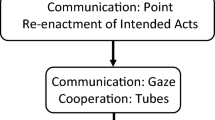Abstract
This study investigated autistic children's use of attention-directing gestures and language in three different interactive situations which varied in social context factors. These behaviors were videotaped and compared in autistic children (n=15), children with developmental language delay (n=14), matched on mental age and mean length of utterance (MLU), and MLU-matched young normal children (n=13). Results supported the hypothesis that autistic children's attention-directing behavior would differ most from that of the other groups in spontaneous interactions. However, contrary to expectation, the autistic children did not produce more attention-directing behavior when a high degree of adult direction was provided. Overall, the autistic group used attention-directing behaviors less frequently than the other groups, and in the autistic group these behavors varied less across social context factors. Results are interpreted in terms of their implications for language intervention programs with autistic children.
Similar content being viewed by others
References
American Psychiatric Association. (1980).Diagnostic and Statistical Manual of Mental Disorders. Washington, DC: Author.
Arthur, G. (1980).Arthur adaptation of the Leiter international performance scale (revised). Chicago: Stoelting.
Baltaxe, C. (1977). Pragmatic deficits in the language of autistic adolescents.Journal of Pediatric Psychology, 42, 376–393.
Bartak, L., & Rutter, M. (1974). Use of personal pronouns by autistic children.Journal of Autism and Childhood Szhizophrenia, 4: 127–451.
Bartak, L., Rutter, M., & Cox, A. (1975). A comparative study of infantile autism and specific developmental receptive language disorder: I. The children.British Journal of Psychiatry, 126: 127–451.
Bernard-Opitz, V. (1982). Pragmatic analysis of the communication behavior of an autistic child.Journal of Speech and Hearing Disorders, 47, 99–109.
Cantwell, D., Baker, L., & Rutter, M. (1978). A comparative study of infantile autism and specific developmental receptivee language disorder.Journal of Child Psychology and Psychiatry, 19, 351–362.
Clark, P., & Rutter, M. (1981). Autistic children's responses to structure and to interpersonal demands.Journal of Autism and Developmental Disorders, 11, 201–217.
Dawson, G., & Adams, A. (1984). Imitation and social responsiveness in autistic children.Journal of Abnormal Child Psychology, 12, 209–226.
Fay, W. H., & Schuler, A. L. (1980).Emerging language in autistic children. Baltimore: University Park Press.
Halle, J. (1988). Adopting the natural environment as the context of training. In S. N. Calculator & J. Bedrosian (Eds.),Communication assessment and intervention for adults with mental retardation (pp. 155–185). Boston: College Hill Press.
Hedrick, D. L., Prather, E. M. & Tobin, A. R. (1975).Sequenced inventory of communication development. Seattle: University of Washington Press.
Hurtig, R., Ensrud, S., & Tomblin, J. B. (1982). The communication function of question production in autistic children.Journal of Autism and Developmental Disorders, 12: 57–69.
Landry, S., & Chapieski, L. (1989). Joint attention and infant toy exploration: effects of Down's syndrome and prematurity.Child Development, 60, 103–118.
Landry, S., & Loveland K. (1988). Communication behaviors in autism and developmental language delay.Journal of Child Psychology and Psychiatry and Allied Disciplines, 29, 621–634.
Locke, A. (1978).Action, gesture, and symbol: The emergence of language. New York: Academic Press.
Lord, C., Merrin, D., Vest, L., & Kelly, K. (1983). Communicative behavior of adults with an autistic four-year-old boy and his nonhandicapped twin brother.Journal of Autism and Developmental Disorders, 13, 1–17.
Loveland, K., & Landry, S. (1986). Joint attention and language in autism and developmental language delay.Journal of Autism and Developmental Disorders, 12, 335–349.
McHale, S. M., Simeonsson, R. J., Marcus, L. M., & Olley, J. G. (1980). The social and symbolic quality of autistic children's communication.Journal of Autism and Developmental Disorders, 10, 299–310.
Mundy, P., Sigman, M., Ungerer, J., & Sherman, T. (1986). Defining the social deficits of autism: The contribution of nonverbal communication measures.Journal of Child Psychology and Psychiatry, 27, 657–669.
Olley, J. (1985). Social aspects of communication in children with autism. In E. Schopler & G. Mesibov (Eds.),Communication problems in autism New York: Plenum Press.
Richer, J. (1976). The social avoidance behavior of autistic children.Animal Behavior, 24, 898–906.
Richer, J. (1978). The partial communication of culture to autistic children: An application of human ethology. In M. Rutter & E. Schopler (Eds.),Autism: A reappraisal of concepts and treatment. New York: Plenum Press.
Rocissano, L., & Yatchmink, Y. (1983). Language skill and interactive patterns in prematurely born toddlers.Child Development, 54, 1229–1241.
Schopler, E., Brehm, S., Kinsbourne, M., & Reichler, K. J. (1971). The effect of treatment structure on development in autistic children.Archives of General Psychiatry, 23, 415–421.
Sigman, M., Mundy, P., Sherman, T., & Ungerer, J. (1986). Social interactions of autistic, mentally retarded, and normal children and their caregivers.Journal of Child Psychology and Psychiatry, 27, 647–656.
Author information
Authors and Affiliations
Additional information
This work was supported in part by National Institutes of Health grant NS18448. The authors thank Robin McEvoy, Michelle Kelley, Belgin Tunali, and Dennis Brunt for their help in coding and data analysis.
Rights and permissions
About this article
Cite this article
Landry, S.H., Loveland, K.A. The effect of social context on the functional communication skills of autistic children. J Autism Dev Disord 19, 283–299 (1989). https://doi.org/10.1007/BF02211847
Issue Date:
DOI: https://doi.org/10.1007/BF02211847




